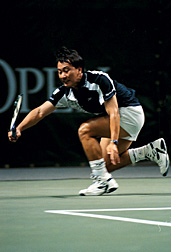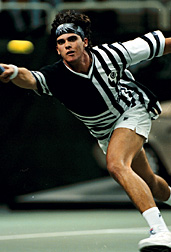|
TennisOne Lessons
Pattern Play Tactics, Part 3:
|
||
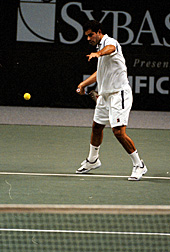 |
Look at the photo of Pete Sampras and take note of his preparation - beautiful racquet set up, open stance, good shoulder turn, eyes focused on the ball. "Great", you say, "but how does that help me with the sneak attack pattern?" To understand that, you must first understand Pete’s thought pattern. A good sneak attacker will plan the attack in advance. Like a billiard player, Pete is thinking one shot ahead, mentally lining up the balls so to speak. As Sampras is about to strike the ball he is already 50% sure he is going to attack. As soon as the ball leaves his racquet, he quickly assesses the situation.
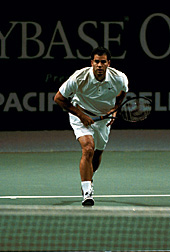 |
The minute he realizes his opponent is on the defensive, he sneaks in anticipating the floater, which he can easily put away.
One more thing, on an approach the split step is performed just BEFORE your opponent strikes the ball. But on the sneak attack it’s better to hit the splits just AFTER contact. Since the ball will usually float back, splitting after your opponent strikes the ball gives you more balance as you move forward to make contact.
For the average club singles player who only comes to the net to shake hands after the
match, I highly encourage you to learn and use the sneak attack pattern. Even if your
opponent succeeds in pulling of a miraculous shot and wins the point, you’ve still
gained an advantage because now your opponent has one more thing to think about.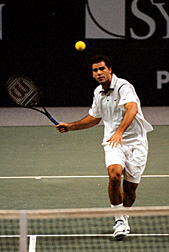 Every time he is on the run and reaching for the ball,
he will no longer have the luxury of just floating a safe response. When in the slightest
bit of trouble, don’t be surprised to find opponents’ going for shots out of
their comfort zone.
Every time he is on the run and reaching for the ball,
he will no longer have the luxury of just floating a safe response. When in the slightest
bit of trouble, don’t be surprised to find opponents’ going for shots out of
their comfort zone.
So remember, to be a good sneak attacker like Sampras, think one shot in advance, sneak in, hit your splits just after your opponent strikes the ball, and rob him of his recovery and set up time. It’s simple, it’s effective
Last Updated 9/1/98. To contact us, please email to: webmaster@tennisone.com
TennisONE is a registered trademark of TennisONE and SportsWeb ONE; Copyright 1995. All rights reserved.
